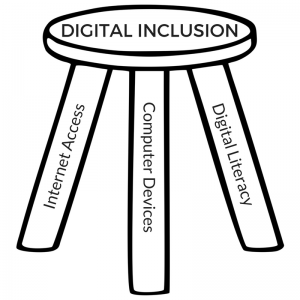
According to the Brookings Institute, in 2016,”… almost 2 billion people remain untouched by digital technology, making it clear that connectivity is neither a panacea for solving the global learning challenge, nor should it be a top education priority.”
Before COVID-19, an academic committee could refuse to offer online access to a meeting for those at other campuses. After COVID-19, this type of “digital redlining” is no longer acceptable, and now everyone has an equal opportunity to attend that same committee meeting.
The best way to solve a problem is to admit you have one. Digital literacy seems to be the shorter leg of the internet access stool, next to digital equity and digital inclusion. I have been a teacher for many years, with a career spanning three states. I think digital literacy should be at the top of the list of every educational institution in North Carolina and the U.S.

At Central Piedmont Community College, we are investigating the creation of a “Campus Culture of Digital Literacy” as an online access solution. In addition to making sure we have a cloud solution for remote or virtual access to basic lab software, Central Piedmont also has standardized solutions for our video chat captioning, hot spot loans, and Chromebook devices.
When COVID-19 first hit, we realized we needed to ask if everyone knew how to use the technology we offered. Our Digital Literacy Committee used CARES Act funding to create a team of researchers who would review the product Northstar Online Learning. This product would offer the training and assessments needed to get a basic understanding of everyone’s digital literacy skills. Not asking your campus about their digital literacy skills can create a Pandora’s Box of problems for those teaching and managing campus technology.
According to Susan Salvo, Kay Shelton, and Brett Welch in a study on “African American Males and Online Education: A Review of the Literature.”1
“Online education requires the learner to have access to technologic equipment such as hardware and digital accessories, productivity software, and reliable Internet access. However, limited access to current technologies may have contributed to African American students (Collins, 2014), and more poignantly, African American male students (McCoy, 2012), to experience poorer educational outcomes. Zhao et al. (2010) reported home computer usage had more impact on digital inequality than school computer usage. … The digital divide is also evident in Internet usage as African Americans, households with lower incomes, and people who lack a high school education are less likely to be online (Zickuhr & Smith, 2012), and students living in rural areas have less Internet access than students living in urban areas (Zhao et al., 2010).”
Knowing that a lack of support for digital literacy training can negatively affect students, it makes sense to support methods that develop a digitally literate college campus. Here are five steps you can adopt to create your own digitally literate campus culture. Remember, this works best if these steps are generated and supported by the top tier of your administration.
Five steps to a digitally literate campus
- Refurbish all technology courses so they are relevant and up-to-date. Have a plan for how you are going to continue to update those courses. Include Open Educational Resources (OER) in your planning. We refurbished the course HSD 6068: Digital Literacy on the roster in our Career and College Ready department, originally developed in 1980. It is now ready for an instructional designer to create an online course version.
- Commit to campus-wide assessments that drive an expected bar of basic competency for all. The bar of expectation has to match what is being asked of students in the classroom. This does not include specialty software for specific fields of study. Northstar Online Assessment is a great tool, but it does not manage itself. You will need an administrator and technical support for data gathering and troubleshooting.
- Plan for a long-term online campus future and put in place all that would make that successful. Taking a “teach first” approach will assure no one will be left behind and miss updates and changes during the introduction of new knowledge. Information technology departments should not become technology salespeople. They should be partners to learning required directly by deans, directors, and other administrators.
- Eliminate barriers quickly. Hesitating to remove the obstacles employees, faculty, staff, and students experience will only exasperate the problems now and in the future. Digital literacy is like getting a free sandwich, making the difference in how a hungry student scores on a test.
- Time is of the essence. Ask your campus faculty senate for help, present to a Student Government Association, create a committee of interested campus supporters, or join a local committee working with the NDIA on digital inclusion. If you face resistance to the forward movement of digital literacy, try to nudge administrators over to the side where everyone’s moral wristwatch is synchronized to students’ same time-sensitive needs.
Wishing away the duty of learning basic digital literacy is no longer an option. Academic politics can kill technology learning and also close roads to upward mobility. Technology can help people connect, work, and learn together. A single decision from one person can hold back digital literacy and set up a community of learners for failure years to come. So, if you want a thriving digital literacy culture, make sure everyone is working together toward that goal as one college.
Recommended reading



